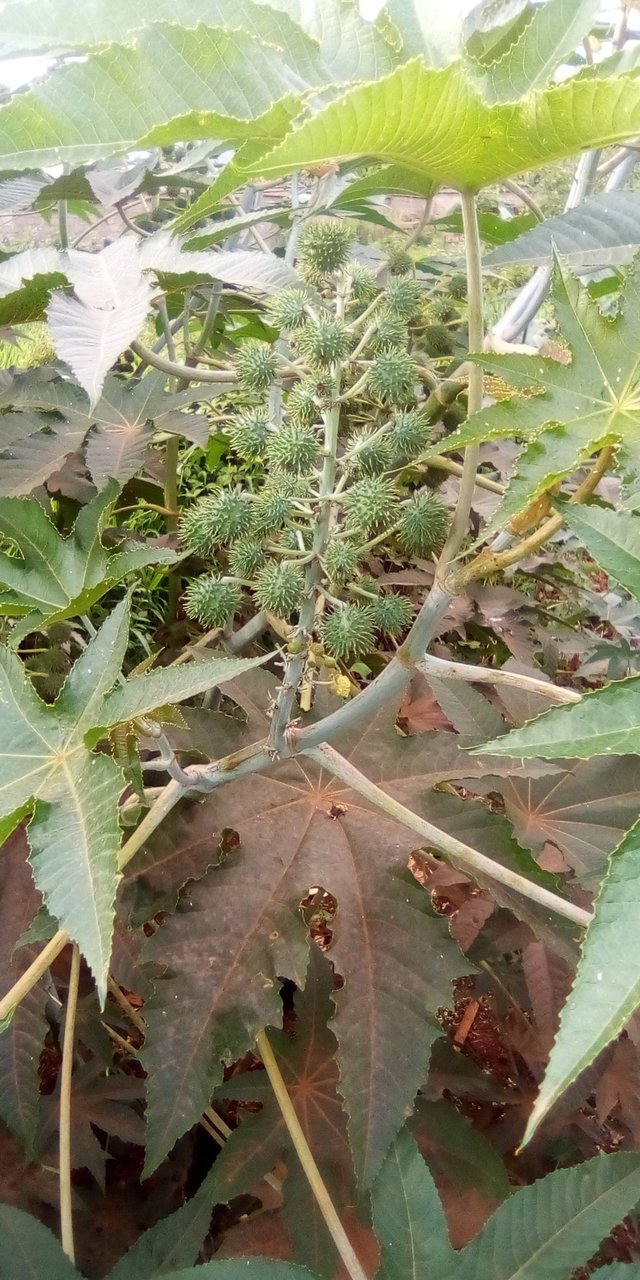
Ricinus communis, the castor bean or castor oil plant,is a species of perennial flowering plant in the spurge family, Euphorbiaceae. It is the sole species in the monotypic genus, Ricinus, and subtribe, Ricininae. The evolution of castor and its relation to other species are currently being studied using modern genetic tools.It reproduces with a mixed pollination system which favors selfing by geitonogamy but at the same time can be an out-crosser by anemophily (wind pollination) or entomophily (insect pollination).
Green variant after blooming, with developing seed capsules
Its seed is the castor bean, which, despite its name, is not a bean (that is, the seed of many Fabaceae). Castor is indigenous to the southeastern Mediterranean Basin, Eastern Africa, and India, but is widespread throughout tropical regions (and widely grown elsewhere as an ornamental plant).
Castor seed is the source of castor oil, which has a wide variety of uses. The seeds contain between 40% and 60% oil that is rich in triglycerides, mainly ricinolein. The seed also contains ricin, a water-soluble toxin, which is also present in lower concentrations throughout the plant.
Ricinus communis can vary greatly in its growth habit and appearance. The variability has been increased by breeders who have selected a range of cultivars for leaf and flower colours, and for oil production. It is a fast-growing, suckering shrub that can reach the size of a small tree, around 12 m (39 ft), but it is not cold hardy.
The glossy leaves are 15–45 cm (6–18 in) long, long-stalked, alternate and palmate with five to twelve deep lobes with coarsely toothed segments. In some varieties they start off dark reddish purple or bronze when young, gradually changing to a dark green, sometimes with a reddish tinge, as they mature. The leaves of some other varieties are green practically from the start, whereas in yet others a pigment masks the green color of all the chlorophyll-bearing parts, leaves, stems and young fruit, so that they remain a dramatic purple-to-reddish-brown throughout the life of the plant. Plants with the dark leaves can be found growing next to those with green leaves, so there is most likely only a single gene controlling the production of the pigment in some varieties.The stems and the spherical, spiny seed capsules also vary in pigmentation. The fruit capsules of some varieties are more showy than the flowers.
The green capsule dries and splits into three sections, forcibly ejecting seeds
The flowers lack petals and are unisexual (male and female) where both types are borne on the same plant (monoecious) in terminal panicle-like inflorescences of green or, in some varieties, shades of red. The male flowers are numerous, yellowish-green with prominent creamy stamens; the female flowers, borne at the tips of the spikes, lie within the immature spiny capsules, are relatively few in number and have prominent red stigmas.
The fruit is a spiny, greenish (to reddish-purple) capsule containing large, oval, shiny, bean-like, highly poisonous seeds with variable brownish mottling. Castor seeds have a warty appendage called the caruncle, which is a type of elaiosome. The caruncle promotes the dispersal of the seed by ants (myrmecochory).
Castor oil has many uses in medicine and other applications. An alcoholic extract of the leaf was shown, in laboratory rats, to protect the liver from damage from certain poisons.Methanolic extracts of the leaves of Ricinus communis were used in antimicrobial testing against eight pathogenic bacteria in rats and showed antimicrobial properties.
The pericarp of Ricinus showed central nervous system effects in mice at low doses. At high doses mice quickly died.A water extract of the root bark showed analgesic activity in rats.Antihistamine and anti-inflammatory properties were found in ethanolic extract of Ricinus communis root bark. Castor oil and the plant's roots and leaves are used in the Indian Indigenous Medicinal System of Ayurveda for various diseases, and it has been investigated in a few limited studies for its potential as an anti-nociceptive and anti-inflammatory herbal medicine.
Extract of Ricinus communis exhibited acaricidal and insecticidal activities against the adult of Haemaphysalis bispinosa (Acarina: Ixodidae) and hematophagous fly Hippobosca maculata (Diptera: Hippoboscidae).
Members of the Bodo tribe of Bodoland in Assam, India, use the leaves of the plant to feed the larvae of muga and endi silkworms.
Castor oil is an effective motor lubricant and has been used in internal combustion engines, including those of World War I airplanes, some racing cars and some model airplanes. It has historically been popular for lubricating two-stroke engines due to high resistance to heat compared to petroleum-based oils. It does not mix well with petroleum products, particularly at low temperatures, but mixes better with the methanol-based fuels used in glow model engines. In total-loss-lubrication applications, it tends to leave carbon deposits and varnish within the engine. It has been largely replaced by synthetic oils that are more stable and less toxic.